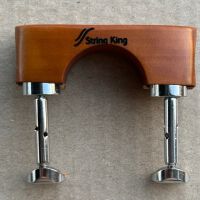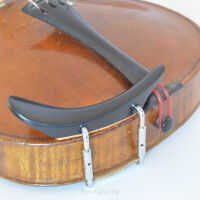Violin/Viola Pad
Violin/Viola Pad – PADDY by String King 
A new and revolutionary String King invention:
Looking at a baroque orchestra on stage is not an entirely uplifting aesthetic experience – elegant and formal concert clothes and beautiful instruments combined with a wild array of personal arrangements of patches and rags hanging under the instruments and falling to the floor.
Almost all baroque violinists (and violists) use different kinds and sizes of leather patches, attached to the instrument or put on the shoulder.
One of the main reasons for using them is to protect the instrument.
Unfortunately, especially in warm weather, the leather absorbs moisture and often sticks to the varnish. When you put your violin with its patch into the case in this condition it will be “glued” to the instrument, when you open it next day. It is of course damaging to the varnish, the wood and to the glue, almost worst than not using any protection. Instruments open very often in the area where it touches the body. On many instruments, old and new, one can clearly see how varnish and even wood have suffered damage after years of use.
With the help of PADDY all that will become only a bad memory and you will save time and money avoiding regular gluing and retouching of your instrument.
If you feel that you don’t need so much material on your instrument you can easily cut PADDY with scissors to the shape you want (but avoid cutting the seams).
You can wash PADDY in lukewarm water with some soap. Put it back into shape and leave it to dry away from a source of heat.
Here comes a simple “installation” instruction:
PADDY on!
* NEOPRENE is a synthetic rubber material designed to act flexibly, durably, and to resist breakdown by water and sweat. It is form fitting and resilient. Because air and water become isolated in its unique molecular structure, Neoprene is temperately stable. The many uses of Neoprene include: wet suits, waders, insulated can holders, sports gloves, mouse pads, pet collars, elbow and knee pads, orthopedic braces, tack gear.
 |
 |
 |
||
 |
 |
 |
||
 |
 |
 |
||
 |
 |
 |
||
A new and revolutionary String King invention:
- Protects your violin or viola from sweat and wear and tear
- Makes holding the instrument more comfortable and less abrasive to your neck and chin
- Firm attachment to the instrument
- Aesthetically pleasing – many different types of leather and variety of colours
- Non-allergenic – (versions in natural un-coloured leather, treated with natural grease)
- Hygienic – washable
- Adjustable – you can cut it to the size and shape that is right for you.
Looking at a baroque orchestra on stage is not an entirely uplifting aesthetic experience – elegant and formal concert clothes and beautiful instruments combined with a wild array of personal arrangements of patches and rags hanging under the instruments and falling to the floor.
Almost all baroque violinists (and violists) use different kinds and sizes of leather patches, attached to the instrument or put on the shoulder.
 |
 |
 |
 |
One of the main reasons for using them is to protect the instrument.
Unfortunately, especially in warm weather, the leather absorbs moisture and often sticks to the varnish. When you put your violin with its patch into the case in this condition it will be “glued” to the instrument, when you open it next day. It is of course damaging to the varnish, the wood and to the glue, almost worst than not using any protection. Instruments open very often in the area where it touches the body. On many instruments, old and new, one can clearly see how varnish and even wood have suffered damage after years of use.
 |
 |
With the help of PADDY all that will become only a bad memory and you will save time and money avoiding regular gluing and retouching of your instrument.
If you feel that you don’t need so much material on your instrument you can easily cut PADDY with scissors to the shape you want (but avoid cutting the seams).
 |
 |
 |
You can wash PADDY in lukewarm water with some soap. Put it back into shape and leave it to dry away from a source of heat.
Here comes a simple “installation” instruction:
 |
 |
 |
PADDY on!
* NEOPRENE is a synthetic rubber material designed to act flexibly, durably, and to resist breakdown by water and sweat. It is form fitting and resilient. Because air and water become isolated in its unique molecular structure, Neoprene is temperately stable. The many uses of Neoprene include: wet suits, waders, insulated can holders, sports gloves, mouse pads, pet collars, elbow and knee pads, orthopedic braces, tack gear.





